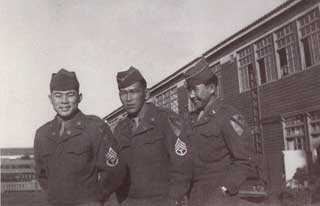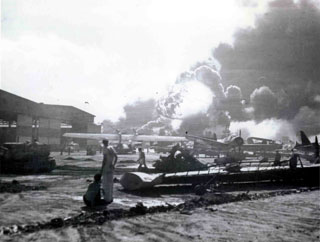Edwin Nakasone: "Japan is attacking us!"
Edwin Naksone was a 14-year old boy living on the Hawaiian Island of Oahu when the Japanese made a surprise attack on nearby Pearl Harbor. He remembered that day in a 2003 interview with historian Thomas Saylor.
Audio
Transcript
TS: When the attack on Pearl Harbor came on [the island of] Oahu on the 7th of December [1941] you were fourteen years of age, in eighth grade, ninth grade.
EN: I was in eighth grade, I believe.
TS: What were you doing that morning and how did you experience that morning?
EN: Well, first of all, let me just backtrack a step. My father did go back to Japan to visit. We were very excited about it. Extremely worried about it because we knew the conditions were being very - foreign relations were being very, very tight as far as Japan. And we finally got word that he was in the last ship coming off [the port city of] Yokohama. So he came back to us in Hawaii about a month before Pearl Harbor. So we were overjoyed to have him back with us.
Okay. Then Pearl Harbor did occur. December 7, 1941. What was I doing? It was about 7:30, 7—oh, about 7:45, 7:55. The first bombs fall at 7:55. I’m having my breakfast. I can remember distinctly what I had. I had Kellogg's Corn Flakes. Not the sugar part. You had to add sugar in there, and a little Carnation milk in that. We didn't have milk, as I said before. So I'm eating and I'm looking out towards the mountains.
TS: Can you see the harbor from there? [Both looking at aerial photo of Pearl Harbor, c. 1941]
EN: Oh, no. The harbor is southwest of us [where we lived]. But next to us, next to Wahiawa, is Wheeler Air Force Station.
TS: That one I recognize. Yes.
EN: Air Field. Over there is the Waianae Range and there is a dip in the Waianae Range, which is called Kola Kola Pass. It's on the west side of Oahu. I distinctly remember having seen about fifteen planes come through the pass toward Schofield [Army] Barracks. Schofield Barracks was right at the base of the pass. And they swooped down. They did not drop any bombs but they machine-gunned the whole place. And they went up again and then they went down in beautiful formation. And as they pulled out there was little pellet-like things dropping down and no more do I see that than I see explosions occur. Flames going up. The planes going up. The buildings going up. Dirt and debris coming up and so on. And I knew something was wrong and so I dashed outside. As I was eating, I dashed outside. And all of a sudden I see a plane rrrrrmmmm coming over. A [Japanese] Zero [single engine, single seat fighter] plane. I can still remember to this day the fact that he had his hatchimati, his headband around, goggles on.
TS: That close he was to you?!
EN: He was no more than two hundred feet up in the air. Then my neighbor, Mr. Leonita, of Filipino background, he was up on his roof fixing his radio. Aerial in those days. He was waving like this to the pilot and the pilot looked down and I can remember he had a scarf blowing in the wind. So I ran back into the house, turned on the radio and what do I hear? Webley Edwards, the regular station KGMB announcer. "All servicemen return to your bases! All servicemen return to your bases! The Japanese are attacking Pearl Harbor and other military bases. All servicemen return to your bases! This is the real McCoy! No joke! It's the real McCoy! No joke! Get back to your bases! Get back to your bases!" Then I knew that war had come.
And when I looked when the plane went up, I could see the great big red meatballs on the side of the fuselage and on both sides of the wings. I hurriedly went into the house, awakened everybody and said, "Wake up! Wake up! Japan is attacking us! Japan is attacking us!" And then later on I was outside. And now by this time all pilots had gone up to—we had a secret airfield in Haleiwa on the northern side of the island. And there you had several of our American pilots from Wheeler Air Force base who were taking their cars, jalopies. It is only about eight, ten miles, to the Haleiwa airstrip. It's on the north shore. A fishing village. These guys had gone up to do battle with the Japanese Zeroes and they knocked down about five Japanese planes. So this was the way—and later on during the morning I see dogfights are going up in the distance. Then one plane, one Zero plane, narrowly missed the power station of our town, power development there. And exploded there and one of the civilians were killed over there.
TS: This attack went on for many hours in that morning?
EN: Well, it was on about two and a half hours. Because the first bombs fell at 7:55 in the morning and at least by 10:30 it was pretty much done. All done.




Source
Nakasone, Edwin; Thomas Saylor, Interviewer, Minnesota's Greatest Generation Oral History Project, Thomas Saylor; Minnesota Historical Society Oral History Collection, 2003.


